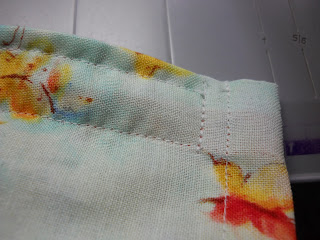It's been a while since I've been here with you! This time of year means lots of costume orders for me, so I've been knee deep in vampire capes and princess dresses!
However, I did take a day off to help my daughter
add 12 inches to a down comforter. We'd been putting this off since last spring, because the weather got warmer for one reason, but fear was another!
Once we'd decided the best way to increase the width of this queen size comforter was to add another row of matching 'squares' to the already existing ones,
we had the curious dilemma of finding goose down. It's not as easy as one might think. We priced pillows and jackets, hoping to steal the stuffing, but that was cost prohibitive. After repeated searches, we finally found it sold by the pound on an online auction site.
 |
| Goose down in its natural state |
Now, we wondered,
how much volume is in a pound of feathers? We ordered a pound. In a few days we had a priority mail medium sized flat rate box stuffed full of feathers! Enough to make a full comforter, as we would find out.
This box sat on my cutting table, then ironing board, then dresser.. you get the idea.
Finally, I dedicated a day to getting the project done. I found a queen size sheet, and cut a 13 inch strip down the sides to create the squares. (Don't fret about the fate of the sheet- it's now twin size!)
After measuring and double checking I sewed the side seams, marked the squares and began stuffing the feathers into the squares.
That was when the real fun began!
 |
| recommended gloves and mask |
Did I tell you that I'm allergic to feathers? No? Well, I am. So I donned vinyl gloves and a mask, reached into the feathers and tried to stuff them in a 13 inch opening. That should have been a piece of cake.
No. It wasn't.
Feathers and feather dust and probably some dead goose skin cells were flying everywhere.
First rule of working with goose down: Close the windows. Turn off the furnace fan. Shut the door.
Once I reduced the air circulation in the room, I tried again. Better, but still a lot of feathers flying. I didn't relish having to pick them up or waste the money I spent on them by vacuuming them.
How to add weight to feathers?
 |
| keep a spritz bottle of water handy- makes clean up easier, too! |
|
Second rule of working with goose down:
Spritz the feathers with water before you work with them.
Water gave the feathers weight, kept them together, made it easier to leave them in the opening without flying back out, plus I knew that since geese got rained on occasionally, the feathers should dry ok.
I also found that two handfuls of feathers was just about right for each of the squares. I pinned them completely closed as I finished each square to keep the feathers in their new home.
 |
| The goose down conqueror at work |
Finishing the sewing was not a problem and the comforter is now a
perfect size!
 |
| Finished comforter- perfect size for a queen! |















































